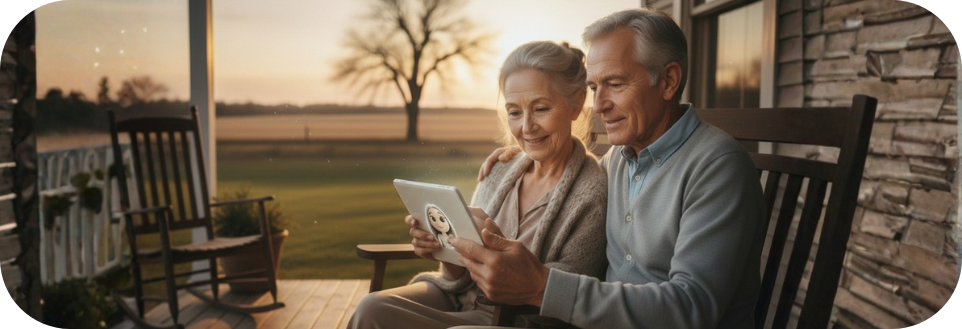Loneliness and Social Isolation in Seniors – Stay Connected
Growing older often brings wisdom, calm, and stories worth sharing but it can also bring profound feelings of loneliness and isolation.
Updated on: 05 Aug 2025

In today’s hyper-connected world, loneliness remains one of the most significant challenges facing seniors. According to the National Institute on Aging, nearly one in four adults aged 65 and older are socially isolated. Another study by the AARP Foundation reported that 35% of adults over 45 feel lonely regularly (AARP Foundation, 2020). These staggering numbers highlight how widespread the issue of loneliness is. But here’s the question: can technology help seniors feel less alone? The answer is a resounding yes when used thoughtfully, technology can bridge gaps, foster connection, and empower seniors to lead more fulfilling lives.
As people age, life circumstances often change. Retirement reduces daily social interaction, friends and spouses may pass away, adult children may move to other cities, and mobility limitations can make it harder to engage with the outside world. These factors often contribute to loneliness and even depression. Loneliness isn’t just an emotional issue. Studies show it increases the risk of chronic illness, cognitive decline, and even premature death. Research has revealed that loneliness can increase the risk of dementia by up to 50% and raise the likelihood of heart disease by 29% (Heart.org). That’s why finding solutions to combat loneliness in seniors isn’t just a matter of comfort it’s a matter of health.

Technology is often portrayed as isolating, especially for younger generations glued to their screens. But for seniors, technology can serve as a lifeline. From smartphones to virtual reality, innovations are opening doors that were once locked shut.
Nothing replaces the joy of seeing a loved one’s face. Video calling platforms like Zoom, FaceTime, and WhatsApp have revolutionized communication. According to Pew Research Center, 75% of seniors who own smartphones use video chat services at least once a week (Pew Research Center, 2021). A daily or weekly video call can give seniors something to look forward to, creating stronger emotional bonds.
While not every senior embraces social media, platforms like Facebook offer a way to stay updated on family milestones, community news, and even local events. In fact, 45% of adults over 65 use Facebook, making it the most popular platform for older adults (Pew Research Center, 2021). Seniors can share photos, comment on posts, and feel more engaged with the lives of their loved ones. This sense of participation reduces feelings of being left out.
From book clubs on Goodreads to support groups on Reddit, seniors can find like-minded communities online. These digital spaces allow them to share stories, exchange advice, and develop meaningful friendships without leaving home.
Devices like Amazon Alexa and Google Assistant aren’t just convenient they provide companionship. According to research by Voicebot.ai, 20% of U.S. seniors use voice assistants daily, finding them helpful for reminders, entertainment, and even casual conversations (Voicebot.ai, 2022). These small interactions can reduce feelings of silence and loneliness.

While technology has incredible potential, there are barriers to adoption among seniors.
Not every senior has access to devices or reliable internet. According to Pew Research Center, 27% of seniors do not have home broadband, limiting their ability to connect online (Pew Research Center, 2021). Programs that provide affordable tablets, smartphones, or internet connections can make a huge difference.
Complex devices can discourage seniors. That’s why senior-friendly devices with larger screens, simple interfaces, and voice commands are essential.
Seniors may feel intimidated by new technology. Family members, community centers, and nonprofits can provide workshops and ongoing support. Peer-to-peer learning groups can also empower seniors to learn together.

Family plays a vital role in making technology meaningful. Here’s how you can help:
When seniors use technology effectively, the emotional impact is profound:
The digital revolution is often criticized for creating distance between people. But for seniors, technology can close the gap. Whether it’s a video call that brightens the day, a virtual trip across the world, or a voice assistant that provides companionship, technology has the power to help seniors feel less alone. Seniors should know about AI Companions which porvides instant, trusted conversation, empathy, and emotional support, ensuring seniors feel connected and always talk in a positive way like ReComune. Loneliness is not inevitable in old age. With compassion, creativity, and the right tools, we can create a future where every senior feels connected, valued, and supported. If we embrace technology not as a replacement but as a supplement to human connection, seniors can live longer, happier, and less lonely lives.

In today’s hyperconnected world, many older adults still experience an invisible silence loneliness. Despite the abundance of digital tools, emotional isolation continues to rise, especially among seniors.
Updated on: 24 Jul 2025